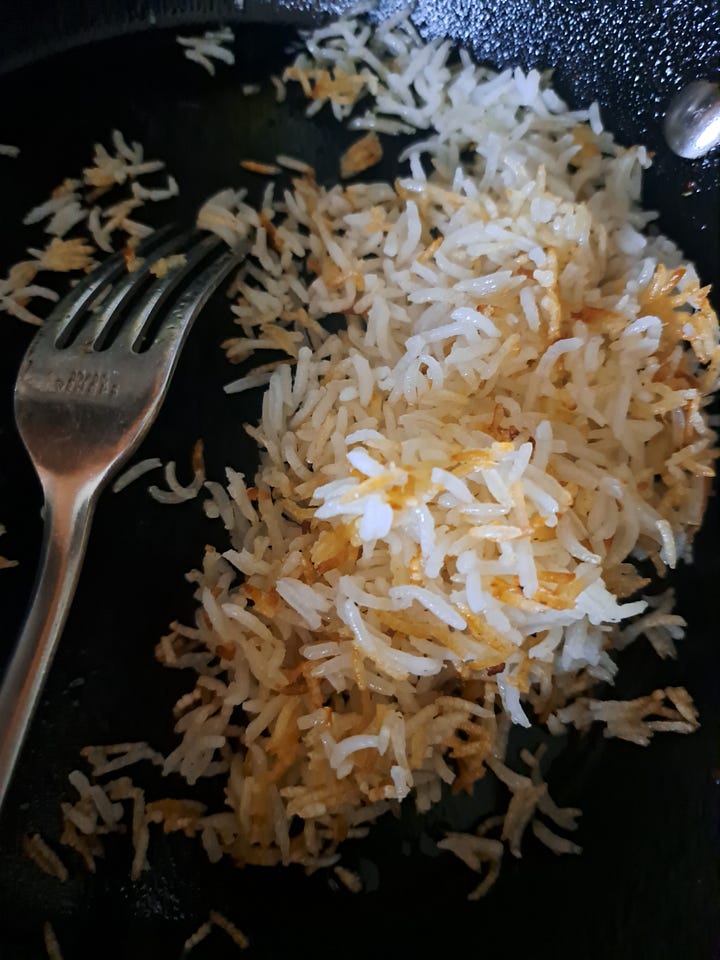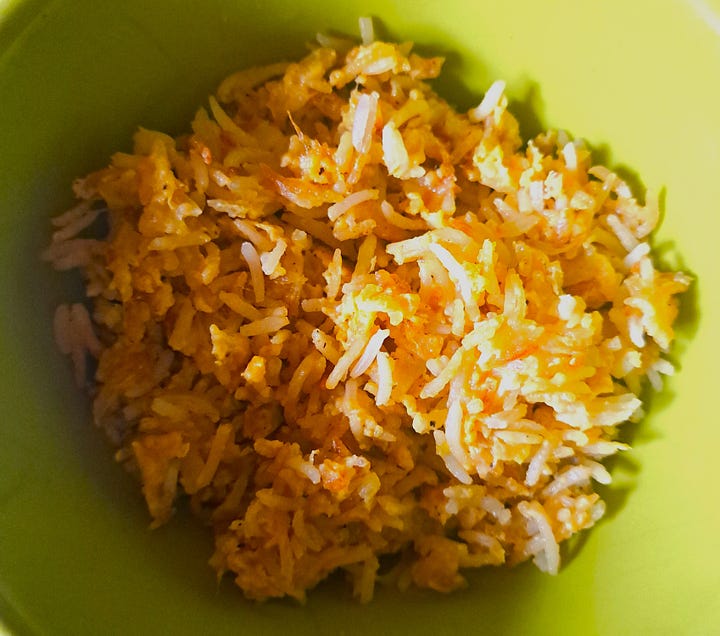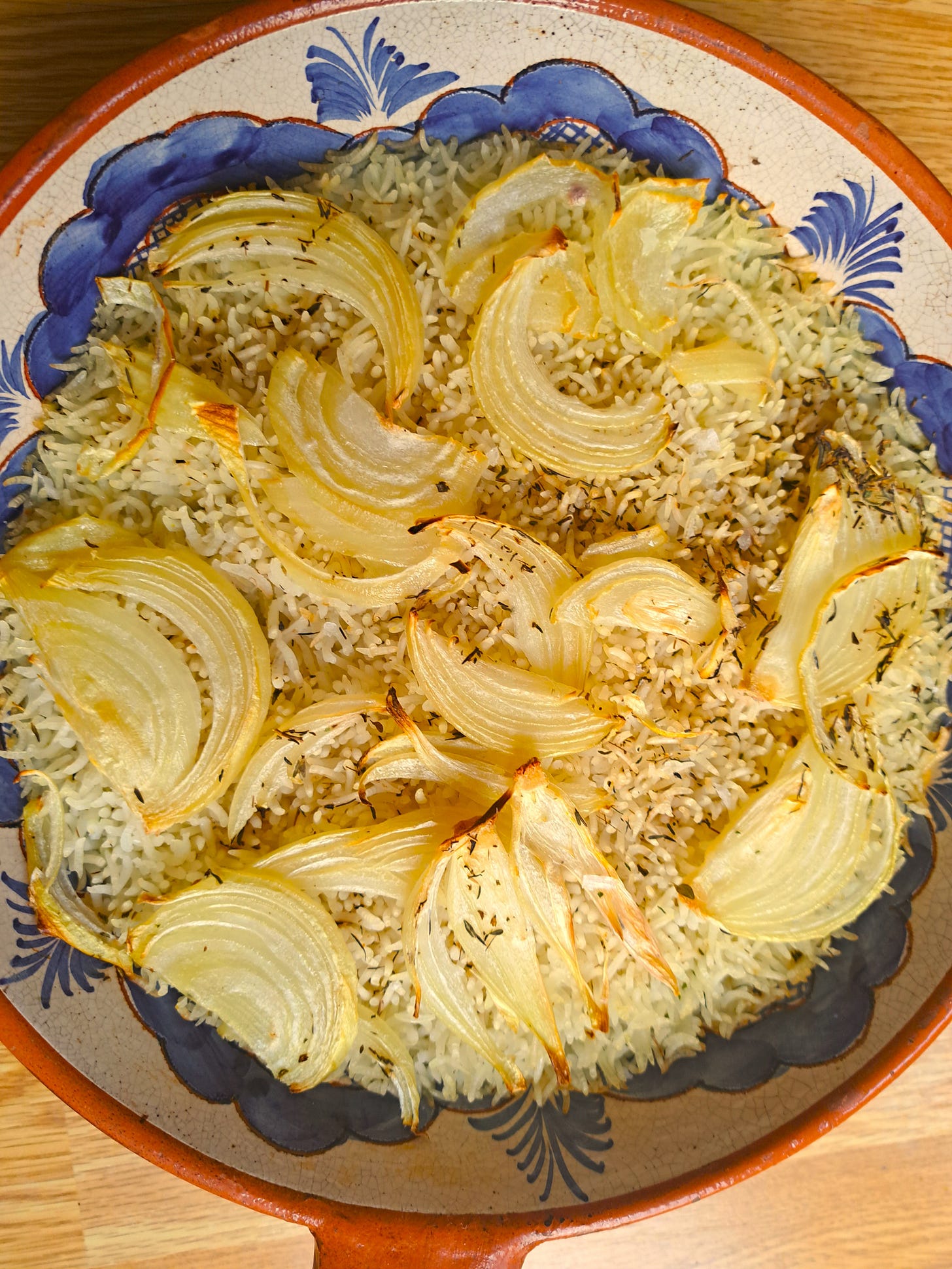Rice
A personal journey from open pan to absorption, whilst avoiding rice pudding* plus two crispy rice recipes.

Rice pudding. It’s always at the top of my list if anyone is kind enough to cook for me and asks ‘is there anything you don’t eat?’
Even writing the words makes my stomach protest. Boring, bland, lumpy, it’s the two dimensional cardboard cut out of food. I understand that many people love it and I’m in the minority but you’re all so wrong and I’m right. And yes, it’s a school thing. Even now as I’m writing these words I can picture the bowl of rice pudding. It’s staring up at me from a shallow old fashioned soup bowl, slightly jaundiced and starting to congeal. Behind me, breathing menacingly over my shoulders is a polyester clad dinner lady. I can’t see her arms but I know they’re tightly folded over her chest.
Historically in this country, everyone apart from me seems more comfortable with rice as a sweet than a savoury dish.
Even today rice puts some people into a panic. I still know people who say they can’t cook rice.
Food writer Sri Owen is the queen of rice lore. She grew up in Sumatra, is an authority on Indonesian food and her rice book is the definitive celebration of the grain. In her piece celebrating Sri, I love Bee Wilson admitting her fear of cooking rice.
Many countries venerate rice; In Japan the word for cooked rice also means meal. It symbolised prosperity and was even used as currency. It probably comes as no surprise that China and India lead the way in global rice consumption.
Growing up, easy cook, Uncle Ben’s style rice was the only type to be found in our house; kept in a glass jar, repurposed from instant coffee. Carefully measured out, then poured into volumes of boiling water and left to steam dry in a sieve over the pan, the name said it all. It never stuck. Easy cook was grade one, first level rice for beginners. The fact that it never tasted of much only occurred to me when I finally got to try other types of rice.
I don’t remember when basmati rice made its appearance but it wasn’t until I’d left home. When I tasted it I felt as if I’d never eaten real rice before. This was rice that had flavour. It was delicate, fragrant and fluffy. I suspect that either my sister or I introduced it, sneaking it in like reverse rice thieves
A soggy overcooked mess that crashed onto plates in mountainous lumps, or a soggy under-cooked mess, bland, under-seasoned and distressingly crunchy
At school, savoury rice was only served with curries. I have no memories of it which is probably a good thing.
On occasional trips to Chinese restaurants my parents ordered egg fried rice that came studded with little jewel like peas and a faint gloss of the cooking oil. It was always delicious. Back at home, mum would occasionally make her own fried rice to use up leftovers. Out came the huge old frying pan and into the hot oil went chopped onion (never garlic), sauteed until soft, then a layer of rice, coated with oil, chopped vegetables, whatever was in the fridge, chicken stock and simmer. Towards the end diced chicken bits were added. By then the pan was full to the brim. We fought over the crispy bits at the bottom of the pan and we devoured it with horseradish and beetroot relish.
It wasn’t until I went to college and lived with other students that rice misery hit hard.
Rice cooked by my fellow students came in two categories. A soggy overcooked mess that crashed onto plates in mountainous lumps, or a soggy under-cooked mess, bland, under-seasoned and distressingly crunchy.
Moving on, I learnt from an Iranian flatmate how to cook rice using the absorption method and also the ultimate in rice dishes; the delicious crispy bottomed Iranian rice dish Tahdig and variations that included putting thin slices of potato at the bottom of the pan.
If you’ve been brought up cooking rice using the open pan method, it takes a leap of faith to believe that the absorption method will work. It takes low heat, not removing the lid, a tea towel and less time than you think.
Living in London in the 1980’s, we discovered the flavourful nutty small grain brown rice served by Cranks. The wonderful Covent Garden basement restaurant Food for Thought served up their daily stir fried vegetables with brown rice in lovely little pottery bowls. Sadly Food for Thought closed in 2015, with Cranks following two years later. I still seek out short grain brown rice from wholefood shops.
Indian restaurants served basmati rice dyed in rainbow colours (to imitate the use of the much more expensive saffron?). I don’t remember when the use of dye stopped but the rice was always delicious.
In a little bookshop I found a slim volume called The Complete Meze Table by Rosamond Man. 1 Even now, the pages fall open onto a recipe for Mujaddarah, rice with lentils, still one of my favourite comfort foods. The blend of cumin and cinnamon with gently cooked lentils and onions, mixed with rice and topped with crisp fried onions is hard to resist. Merged in time with this book comes Claudia Roden’s 2 Book of Middle Eastern Food. I still remember picking vine leaves from a neighbours’ garden, blanching them and spending most of a day stuffing the leaves with rice, currants and spices.
Sticky rice was the next step; encountered in Thai and Japanese restaurants. It’s another leap of faith to get to love the glutenous texture, especially trying to ignore the past experiences of lumpy overcooked Carolina or Patna rice. At a Northern Thai restaurant in Shepherds Bush, the sticky rice came to the table in beautiful little woven containers that kept the contents hot; it was love at first sight.
Learning to cook risotto is a senior step in rice appreciation, especially learning about the types of rice available and the difference they make to starch content, texture and liquid absorption. I felt especially proud making a batch of risotto in a professional kitchen and getting a thumbs up from the head chef. A world of rice was opening up; from pilafs, plov and paella to jollofs, dirty rice, bibimbap, Mexican rice, onigiri, Nasi goreng… the list of rice dishes to explore is endless. Working in India, in Lucknow I was shown how to make a dum biryani, the pastry sealing in the steam from the pot.
More recently, my favourite return to rice recipe has been basmati rice and orzo from Jerusalem by Yotam Ottolenghi and Sami Tamimi.3 As they say, you may never want to cook plain rice again.
According to Kew Gardens, the only two types of cultivated rice are African rice (Oryza glaberrima) and Asian rice (Oryza sativa) but from them stem so many glorious varieties, some only used for one particular dish. There are so many, it breaks my heart if I’m served easy cook rice; it’s rice with its soul removed. In Portugal, finding and buying a rice variety I’d never heard of, I was asked if I knew how to cook the particular dish it was tied to.
How can it possibly make one fat? Indeed it may be said to puff up rather than to make fat.’’
Rice has been popping up in English cookery books since the middle ages.
In 1390 it appears in The Forme of Cury 4
For to make a potage of rice
Take rice and les them and wasch them clean and seth them tyl they breste and than lat them kele and seth cast ther'to Almand milk and colour it wyth saffron and boyle it and present it forth.
Widespread eating of rice only started in the 15th century, usually in the form of a pudding. Rice was an expensive ingredient but by the 1700’s, according to Colin Spencer in his book on British Food 5, rice was a despised food associated with East End Chinese labourers.
Eliza Acton 6 in 1845 gives clear instructions for cooking rice to serve with a curry. She also has a recipe for simple Turkish or Arabic pilaf, kedgeree and risotto a la milanise.
She doesn’t specify what type of rice for these dishes but she does observe;
‘The reader should bear in mind what we have so often repeated in this volume, that rice should always be perfectly cooked, and that it will not be tender with less than three times its bulk of liquid.’
In 1925 The Gentle Art of cooking by Mrs Lloyd and Miss Hartley 7 has a chapter on rice and other cereals. Rice is divided into Patna (for curries and savouries) and Carolina (for puddings).
Their recipes include Rice A L’Italianne (rice, butter, seasoning, tomato, Parmesan), rice with green peas and an intriguing sounding rice in red wine (apples, red wine, rice, sugar).
By 1932 Florence White in Good things in England 8 was sharing Colonel Herberts instructions for boiling 4-6 ounces of rice in a four quart saucepan.
In 1954 Dorothy Hartley notes in Food in England 9
that “East End women make a rice pudding using broth ... when cooked it is finished under the joint of Mutton.’’
She quotes from Gervaise Markham writing in 1615;
‘‘If you will sow rice, you may doe it, but it is like to prouve a work of curiositie rather than of profit, for rice is a commoditie belonging to growing amongst indians...if you boyle rice in milk adding thereto sugar and cinnamon, it will provouke into venerie. many do think it maketh fat...How can it possibly make one fat? Indeed it may be said to puff up rather than to make fat.’’
She also gives a recipe for Thunder and Lightening
Plain boiled rice, piled up and served with golden syrup.
And an intriguing recipe dating from ‘Mr Stephenson’s new steam railway’ called
Sleepers or Dormers.
Boiled rice, freshly drained, seasoned with chopped fresh herbs, mixed with an equal quantity of cold minced meat. The whole is pressed whilst hot into a flat tin and left to set, and when cold cut into slices (sleepers), egg and crumbed and fried. Serve with beef gravy if the meat is beef, melted red currant jelly if mutton is used, or apple sauce if made with pork scraps.
As a change from the usual rissoles they are highly recommended.
According to the Rice Association, Rice eaten per person per week has grown 530% since the 1970s, with 88% of UK households buying rice.
Our love for cuisines that features rice continues to rise so the increase in consumption is not surprising.
Is our relationship and our respect for rice changing? We’re not a rice growing nation but I don’t believe that’s any reason not to respect an ingredient. We love curry but we don’t grow the spices. Are we still scared to cook rice at home?
I don’t have a rice cooker but I do have an electric pressure cooker which is a boon for cooking brown rice in 6 minutes.
Here’s the other rice dish my mum made which relied on the absorption method.
Baked rice
Rice wasn’t just boiled when I was a child. It was baked too. Crispy on the top, it was served as part of a Sunday roast. Sometimes pieces of potato are nestled among the rice. It’s still a comforting dish all my family love.
You’ll need
A shallow oven proof dish. If you’re not sure what size is best, put the rice in first; it should cover the base easily with no gaps.
Rice, basmati for preference
A medium onion, sliced thinly
Chicken or vegetable stock (approx double the amount to rice)
Mixed dried herbs & a big pinch of salt
Oil
Preheat your oven to 180C if not a fan oven.
Grease your dish with oil.
Add rice to cover the base generously
Pour over the stock and salt to cover and sprinkle with a pinch of dried herbs. Put into your oven. After about 20 minutes add the sliced onions to cover the top of the dish and return to the over for another 20 minutes. Check to see if the rice is cooked; you might need to top up with more stock/hot water. The top of the rice should be golden and crunchy.
Serve with your favourite main course; I love it with a caper rich tomato and courgette sauce, or with tzatziki.
If you happen to have leftover rice in the fridge, consider making my favourite breakfast:
Egg fried crispy rice


There are those who prefer their breakfast crispy rice to be sugary snap and pop. I prefer it savoury and I’ll often cook more rice than I need the night before in order to have leftovers.
You need; to serve one
Leftover white or brown rice about one breakfast cupful
A knob of butter/ghee
An egg, preferably organic
soy sauce
chilli sauce of your choice
A small heavy based frying pan
Melt the butter in your pan. Once it starts to sizzle, add the rice and spread out to a thin layer. The heat needs to be medium high; you’re getting the rice to lose its water content and crisp up. Don’t move it around the pan, have faith. Brown rice takes longer than white but it will crisp up too. If it’s getting too crispy ie overcooked, turn down the heat. The rice will lose some of its volume; that’s the time to check if it’s ready. White rice takes about 5-6 minutes. Brown rice can take up to 10 minutes.
Crack the egg into a small bowl and mix in half a teaspoon of soya sauce. Quickly mix it into the rice (you can turn the heat off at this stage; the residual heat will cook the egg). Give it a minute to cook and serve with chilli sauce or more soya sauce. Devour.
* I gave in to Indian sweet rice pudding. No milkiness is involved. It’s delicious
Ebury Press 1986
Penguin 1986
Ebury Press 2012
Oxford University Press 1985
Grub Street 2004
Penguin books 1974
Quadrille 2011
Persephone Books 2003
Futura 1985




Fascinating and thorough! We’ll have to agree to disagree on rice pudding though 😂
When we meet (not sure when) I will have to share with you how I cook rice and the kisoorie I make with basmati, red lentils, onion, salt and turmeric - the ultimate comfort food from my childhood. Rice is a huge part of my marriage 🤣